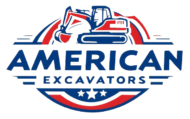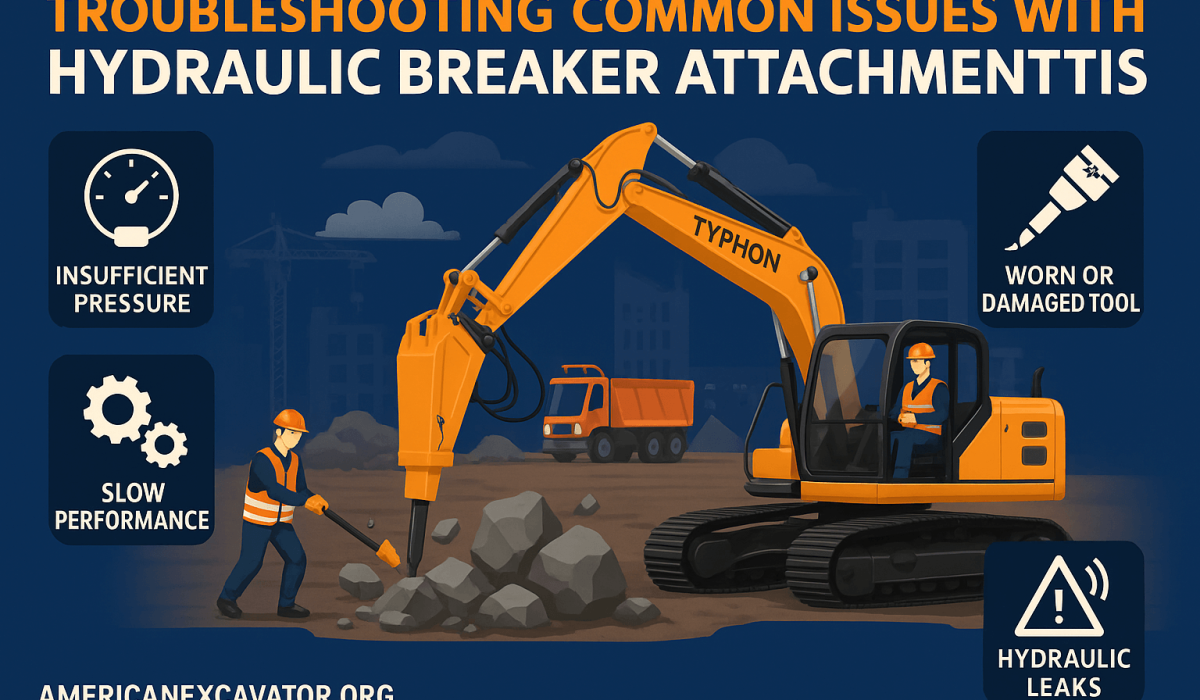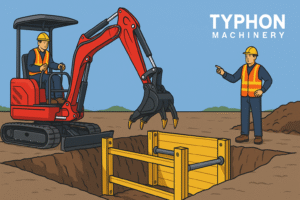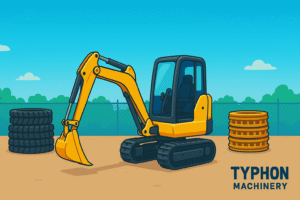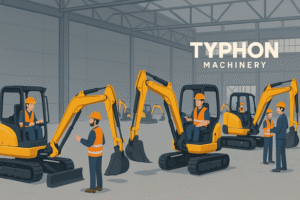Troubleshooting Common Issues with Hydraulic Break Hammer Attachments
Hydraulic break (or “breaker”) hammer attachments are some of the most necessary tools in demolition, rock breaking, quarrying, and other heavy construction works. Nevertheless, like any other complex hydraulic equipment, they are also susceptible to problems from time to time which might cause them to stop working for a period, lower the output, or even lead to machine damages.
This guide is about the most frequent problems with hydraulic hammer attachments, the ways of step-by-step troubleshooting, giving some hints for preventive maintenance and providing some of the common questions and answers that a person who has a hydraulic break or is a local operator experienced may be interested in knowing.
Note: In general, you should always be in line with safety rules and the manufacturers’ instructions during diagnosis and repairs of the hydraulic system.
Top 7 Troubleshooting Hydraulic Break Hammer Attachments:
No Impact / Hammer Does Not Strike
No Impact or No cycling are among the most frustrating problems which are also very frequent; that is when a hydraulic hammer is simply power not called.
Possible Causes & Troubleshooting Steps:
Closed shutoff valves or improperly engaged quick couplers
- The hammer’s shutoff valves (often located on the boom or stick lines) may have been closed unintentionally or closed by a small vibration.
- The quick couplers may not be fully latched, or the internal parts may be broken, thus restricting the flow of fluid.
- Solution: Checking whether both pressure and return lines are open is the first thing to do. Fully check and reengage quick couplers.
Incorrect hose connections or reversed lines
- In the event that the pressure/feed and return lines have been switched (or misrouted), the hammer will not be able to operate in a proper manner.
- Action: Identify the location of the auxiliary hydraulic lines in relation to the control block or valve stack and confirm the correct routing (pressure to pressure, return to tank).
Oil leakage or improper hydraulic pressure.
- Internal leaks (e.g. worn seals, damaged piston) might make the installation of the exerting part of the pressure necessary for striking impossible.
- External leaks (hose rupture, coupling leaks) lower the effective pressure from which the machine will draw.
- Action: Look for visible oil leaks, do the necessary tightening or replacement of the fittings, and take the pressure test.
Overcharging of nitrogen pressure (in nitrogen-charged breakers)
- Excessive gas pressure in the back head or the accumulator can make the piston stop going up (over-balance) hence the impact will be stopped.
- Action: Let the nitrogen out or modify the charge in line with the manufacturer’s specification.
Friction or Internal Directing in the Mechanical Parts
- The power of the jammed tool bit, broken internal part, or misaligned components can be enough to stop mechanically the movement of the piston.
- Action: Take out the chisel/bit, look inside the housing, check the tie rods and internal alignment.
Low Impact / Weak Hits
Even though the hammer can be cycled, the power of the strike might be weak or not very consistent — a very serious issue of performance.
Common Causes and Remedies:
Insufficient hydraulic flow or pressure
- The excavator’s auxiliary circuit may not provide enough flow (liters per minute) or pressure (psi/bar) for the tool.
- Maybe the hoses are undersized, kinked, or partially blocked.
- Solution: Confirm with a flow meter or a gauge that the hammer is getting the required flow/pressure according to its specification. Adjust pump settings or routing. (Dekai Construction Machinery)
Internal leakage (seals, piston, valves)
- Ruptured or worn seals that are located inside the hammer let fluid leakage that in return decreases the force of the tool.
- Component (spool, shuttle, switching valve) of the valve may be malfunctioned or stucked.
- Solution: Take apart and check for internal seals and replace any that might be weakened or damaged O-rings, sliding parts, or valve elements. (JIANGTU)
Low or leaking nitrogen charge
- No gas pressure cannot give the stored energy or the cushion effect, thus, blow strength is reduced.
- Solution: Fill nitrogen in the accumulator or back head again. Release the diaphragm or gas seal if any. (JIANGTU)
Worn lower bushing / excessive clearance
- In case that the close fit between chisel and bushing is worn out, the piston might lose its positioning and transfer the energy to the rest of the parts in an inferior quality causing scuffing or weak strikes.
- Solution: Inspect the clearance, and if it goes beyond the allowable tolerance, then the bushings need to be replaced or surfaces should be re-machined.
Contaminated or overheated hydraulic oil
- Dirty oil may contain air, water, or particulate contaminants, and in addition, oil that is too hot will lower the performance of the entire system.
- The hydraulic circuit should be flushed, filters installed or cleaned, and the oil temperature should be maintained at the correct level. (JIANGTU)
Irregular / Uneven Impacts
There are some cases when the hammer manages to work but the impact rhythm is erratic or inconsistent (e.g. skips, blank blows, fluctuation).
Troubleshooting Steps:
Gas pressure imbalance
- The reason for the switching mechanism to misfire is the nitrogen or gas pressure in the accumulator which is unstable or leaking.
- Solution: Perform gas pressure testing, gas system refill, or repair. (JIANGTU)
Valve or shuttle valve sticking
- It is quite probable that the internal valve or piston shifting valve is sticking or fouled, thus the flow is delayed or misrouted.
- Solution: Disassemble the valve and clean it. Proper lubricants should be used and if any worn parts exist, they should be replaced.
Tool/chisel slippage or misalignment
- The reason of the stroke variance can be the chisel shift if it is under load.
- Solution: Use the locking pins to securely clamp or lock the tool and ensure the proper fit. (JIANGTU)
Intermittent hydraulic supply / pump fluctuation
- An excavator pump or auxiliary circuit that gives fluctuating pressure can cause the hammer to be irregularly spiking.
- Solution: Include the Inspection of Pump Stability, Hydraulic Filters, Relief Valves, Etc. (JIANGTU)
- Overheating can cause the degradation of the rubber parts, the oil, and the internal components, and it is usually just a symptom of the machine.
Main Causes & Solutions:
Completely closed or partially restricted return pathways
- If the line or port for return is blocked, then back pressure will cause heat.
- Solution: Remove the filters, check the return line route, confirm the free flow of the line.
Oil volume too low or oil starvation
- Oil flow through a hammer or a system that is less than required means there is not enough cooling.
- Solution: Make sure oil volume and flow are correct. Check the pump and the auxiliary line specifications. (Dekai Construction Machinery)
Long and continuous usage beyond set limits
- Non-stop operation of a high duty hammer can make it overheat and go beyond its thermal limits.
- Solution: Rest cycles can be formed, cool-down periods can be allowed, and temperature can be monitored.
Poor heat dissipation / Unfavorable environmental factors
- Dust, debris, or a lack of airflow around the breaker or the hydraulic lines can completely surround the components with heat.
- Solution: The cooling can be improved by cleaning the fins for ventilation and protecting the lines from radiant heat.
Excessive Vibration, Noise or Resonance
Typically, abnormal vibration and noise as primary symptoms of alignment or mechanical faults, which, if left untreated, can gradually get worse.
Potential Faults and Solutions:
Misaligned tool / chisel
- Misalignment Misalignment side-loading which cause vibration and noise also is introduced.
- Solution: Realign the machine, change the worn parts, redo the tolerance.
Loose bolts / tie rods
- The tie rods (side bolts) are not tight, broken or cracked as a result of which the components are shifting.
- Solution: Check all the tie rods every day, torque to specification and replace the ones which are damaged.
Imbalanced internal parts
- Imbalanced harmonic may be caused by wear, damage, and unevenness of components.
- Solution: Take apart, identify, rebalance or replace the parts.
Excessive clearance in bushings
- The great play in bushings allows slack and vibrational movement.
- Solution: Measure and fix the bushing clearance.
Fluid hammer or pressure spikes
- The sudden changes of flow or the abrupt closure of the valve can cause hydraulic shock (“water hammer”) in the system.
- Solution: Use accumulators, suitable dampening valves, slow valve actuation.
Oil Leakage (Internal or External)
Leaks are a banned flag — they waste fluid, bring down pressure, and most of the time signal seal or structural failure.
Leak Types & How to Address Them:
External leaks (hoses, couplers, fittings)
- Oil that leaks externally from hoses, couplings, or joints can be seen.
- Solution: Tighten the connections, change the worn hoses or O-rings.
Internal leaks across seals or pistons
- Fluid passing seals internally leads to loss of pressure and reduced impact.
- Solution: Take apart the device and change the worn internal seals, O-rings, or pistons.
Gas capsule/nitrogen chamber leaks
- Gas leaking into the hydraulic chamber or to the atmosphere can make performance difficult to maintain.
- Solution: Change gas seals, diaphragms, and gas valves.
Cracked housing or component fatigue
- Cracks in the structure, no matter how small, may be sources of leaks when under pressure.
- Solution: Fix by welding or replacing the parts that are pushed back.
Wear, Scoring, or Damage to Internal Surfaces
When components such as the piston, cylinder, or tool driver surfaces are worn, the hammer’s lifespan and performance are lowered to a great extent.
Key Failure Modes & Prevention:
Scoring or scratching of piston/cylinder surfaces
- Debris, misalignment, or insufficient lubrication are the main causes of such a process.
- Prevention: Use clean hydraulic fluid that can lubricate well, so that the parts can last longer.
Erosion or fatigue of chisel/tool tip
- Wear out of the product, the wear of the product, or the fall of a product against an unwanted surface are the sources of the method tool.
- Prevention: Use a proper tool material and geometry for the job, and do not wait for catastrophic break to replace it.
Excessive bore wear
- The bore in the cylinder, however, may gradually wear and thus increase the clearance and reduce the efficiency of the whole system.
- Prevention: Check the clearances, re-machine, or replace the part when the tolerances have degraded.
Bolt thread or bracket fatigue
- While the stresses may usually be small, the mounting brackets, bolts, or housing welds may still be cracked or in a state of fatigue due to repeated application.
- Preventive maintenance: Regular inspection; torque checks; do not overuse beyond the rated design.
Daily inspections
- First of all, one has to check if there are any loose bolts, oil leaks, hose abrasions and other abnormal wearings.
- In every shift, nitrogen pressure has to be checked and the tool fit has to be confirmed.
Lubrication discipline
- The use of one or another lubricant (grease or paste) between the tool and the bushing has to be a standard procedure to ensure the reduction of friction and wear of the surfaces.
- It is important to apply lubricants and at the same time follow manufacturers’ recommendations on products used and intervals.
Cleanliness is crucial
- To keep hydraulic fluid, filters, and hoses, avoid dirt, water, and metal particles contamination.
- The use of good quality filtration is a must and filters have to be changed when it is time.
Monitor operating parameters
- Temperature, pressure, and flow have to be kept at normal levels or within recommended limits.
- Put up gauges or sensors in the case that they are not part of the standard set-up.
Limit extreme duty cycles
- Long continuous hammering even in harsh conditions without taking a break should not be allowed.
- Furthermore, you can rotate your tools or jobs to spots where less thermal stress is applied and so you are able to reduce the heat problem.
Adhere to rebuild/service schedules
- With the help of disassembly procedures (valves, seals, bushings), part replacement that are done before wear happens is possible.
- Only correctly trained staff is allowed to carry out the most thorough disassembly.
Operator training & correct usage
- Operators have to be sure that side-loading, prying at angles, or levering the tool sideways is not done by them.
- Moreover, the use of correct methods will diminish the load that is put on the hammer and the excavator.
FAQs: Hydraulic Hammer Troubleshooting
Why does my hydraulic breaker strike weak after some hours of use?
This situation is often caused by heat buildup, fluid viscosity change, or nitrogen gas leakage. So, you can check oil temperature, gas charge, and internal leaks.
How often should I recharge nitrogen in my hydraulic hammer?
It really varies with usage, but quite a few of the breakers are checked on a monthly basis or during every major service cycle. If blow power declines or hose vibration appears, then you should check the gas.
Can I swap the pressure and return hoses temporarily to test a non-firing breaker?
It is sometimes done as a short-cut diagnostic but if done incorrectly can result in valve or backpressure damage. Just do it if you know the hydraulic routing and have a plan to go back.
What is acceptable lower bushing clearance before replacement?
The amount of acceptable clearance is generally very small (~0.1 to 0.5 mm depending on model). Always check the manufacturer’s specification sheet before any tolerances are exceeded.
How to recognize a valve or shuttle inside the hammer that is stuck?
The signs are missing impacts, slow operation, or only hitting unintentionally. Break down the unit, look at the valve spool, or use movement test with a clean solution and see if it moves.
Is it safe to operate a hammer with one broken tie rod?
No, operating with even one failed tie rod is like playing with fire. It will cause structural dislocation, internal destruction, and serious failure, among other things.
What is the proper hydraulic oil specification to ensure the best hammer performance?
The best camel will be one that is fully in line with the OEM specifications of the excavator along with the proper viscosity, cleanliness rating (for example, ISO 4406), and compatibility with the hammer seals. Don’t use synthetic blends unless the manufacturer clearly states that they are compatible.
Hydraulic Break Hammer Troubleshooting – Guide To Remember
Working through the issues of hydraulic break hammer attachments may appear overwhelming, but a step-by-step plan enables you to find out the main reason, fix or change the impacted parts, and make the full function be back again. Always keep the preventive maintenance plan in mind – performing the various checks, having clean hydraulic circuits, using the right nitrogen pressure, and doing the correct alignment are your strong shield against expensive downtime.
This article for AmericanExcavator.org could be a source of reference for your readers – you might like to supplement it with diagrams, photos, model-specific specs, or manufacturer checklists for your audience. In case you want I can also make a downloadable checklist or field guide version.
Focus Keywords:
hydraulic break hammer troubleshooting, hydraulic hammer issues, hydraulic breaker problems, excavator hammer troubleshooting Secondary / supporting keywords: hammer attachment maintenance, hydraulic hammer repair, hydraulic breaker diagnostics, excavator attachments troubleshooting, common hammer faults
